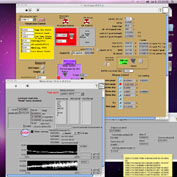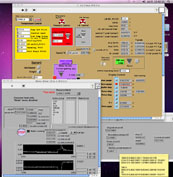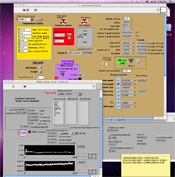Legend: Upper graph of each pair is motor speed V (proportional to edot); lower graph is load (in volts). Translate motor V to edot thus: V1.00 ≈ 6e-6/s ≈ 2%/hr. Load to stress translation for ice767 is roughly ____ MPa/mV, with a __ mV zero offset. Horizontal scale is time. 5000 ≈ 14 hrs.
.thb.jpg)
e = 0.174
End of step (3). Looks like work hardening lasted not more than 1-2% strain since previous.
7/10/14 0938 hrs
.thb.jpg)
4% strain into step (3) and it still seems to be work hardening. Have to guess this is related to the alumina dust.
7/9/14 1737 hrs
.thb.jpg)
End of step (2) to start of step (3), again a 50% increase in stress. But this time edot has increased by a factor of ~3, meaning n is almost 3.
7/9/14 1030 hrs
.thb.jpg)
Last ~14 hrs of step (2); not that much hardening or softening.
7/9/14 0901 hrs

~14 hrs of step (2), shows apparent hardening as edot drops over the first 1% or so of strain.
7/8/14 2323 hrs

End of step (1) to start of step (2) at 50% higher stress. edot barely doubled, meaning n ≤ 2.
7/8/14 1042 hrs

Step (1), most of step. Came to steady edot (top chart) without much strain hardening or softening, which is typical of GSS creep without grain growth.
Note that through 3% strain, this material is weaker than pure 3 x P-dropped ice. I'll create a plot...
7/8/14 0733 hrs